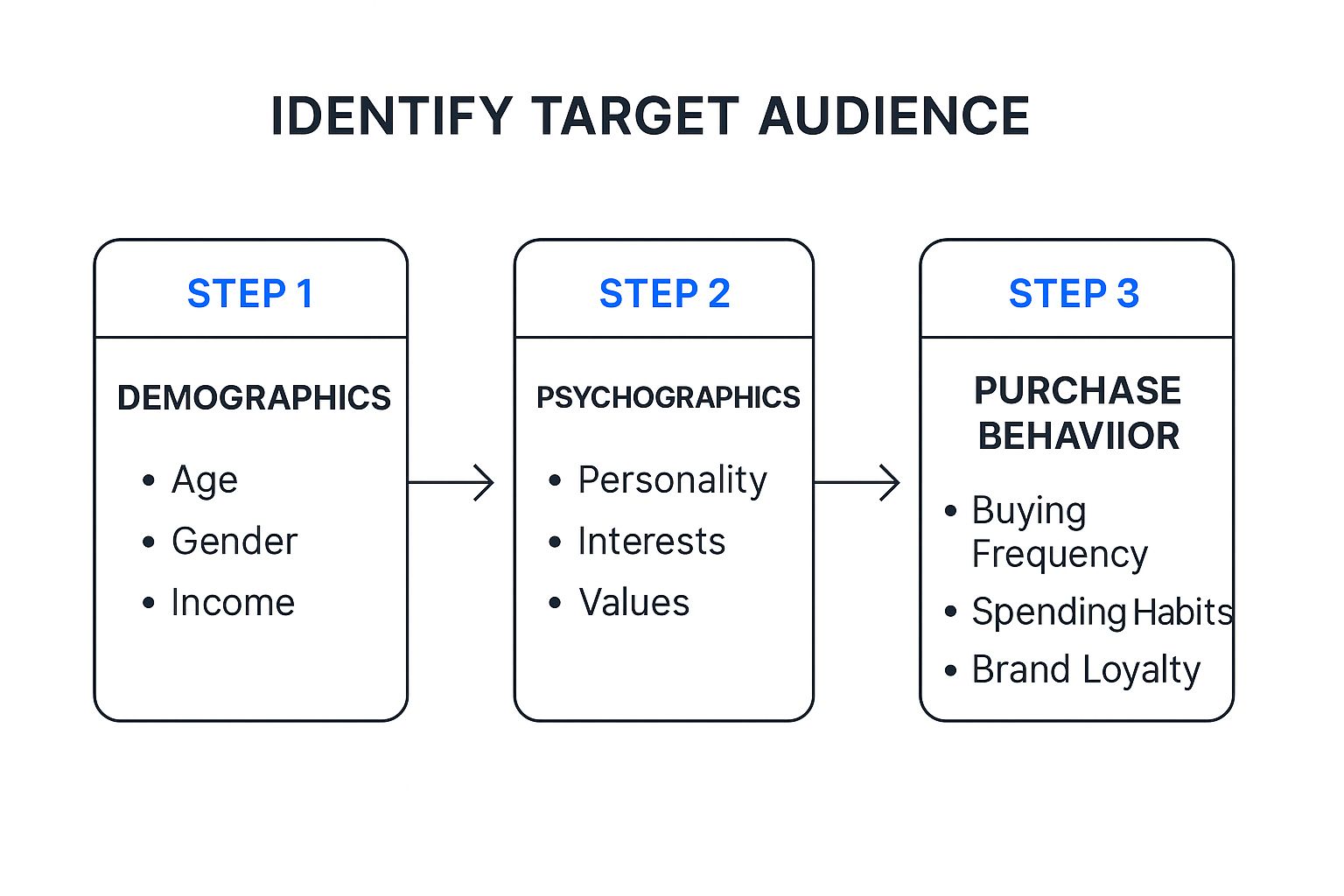"Target audience" is one of those terms that gets thrown around so much it starts to lose its meaning. But at its core, it’s simple: identifying your target audience is about figuring out the specific group of people who are most likely to love what you sell.
This isn’t just about demographics. It’s about diving into their behaviors, their values, and their pain points to build a crystal-clear picture of your ideal customer. That picture becomes the North Star for every marketing decision you make.
Let's be real: the 'spray and pray' approach to marketing is dead. It's a fantastic way to burn through your budget and get ignored by pretty much everyone. This is why knowing how to zero in on your target audience isn’t just a "nice-to-have"—it's the only way to build a sustainable business.
Without a clear profile of who you’re talking to, every ad you run, every piece of content you create, is a shot in the dark.
Imagine a premium, eco-friendly coffee brand pouring thousands of dollars into ads aimed at college students whose top priority is the cheapest caffeine fix they can find. The message, the price, and the values are completely out of sync. It’s a classic case of a great product being shown to the wrong people, leading to abysmal conversion rates and the false conclusion that "the ads aren't working."
Precision targeting isn't a tactic; it's the foundation of your entire marketing strategy. When you truly understand your audience, every ad, every email, and every product feature suddenly becomes more powerful.
You’ll start seeing real, tangible results that ripple across your business:
The goal is to stop shouting into a crowded room and start having a one-on-one conversation with people who are actually waiting to hear from you.
Before we dive into the nitty-gritty, it's helpful to see the big picture. The entire process of identifying your audience can be broken down into three core phases, moving from broad research to a highly specific, actionable customer profile.
This three-phase approach ensures you build a complete picture of your ideal customer—moving from who they are to how they think and act.

Once you have this deep understanding, you can choose the right channels and tactics to reach them. This could be anything from targeted social ads to tangible touchpoints like custom promotional giveaways that create a memorable connection.
This guide will walk you through this exact process, step by step.

If you really want to pinpoint your target audience, you have to move past surface-level assumptions. It's time to dig into the 'who' and 'why' behind your customers by mixing hard data with real human insights. This means looking at both demographics and psychographics.
Demographics tell you who your customers are—the straightforward, quantifiable facts like age, location, and income. Psychographics, on the other hand, get to the why they buy. This is all about their values, lifestyles, and biggest frustrations.
The real magic happens when you combine the two. Knowing your audience is 35-year-old women is one thing. Knowing they are 35-year-old women who prioritize sustainable products and value convenience is a game-changer for your marketing strategy.
Your current customer list is an absolute goldmine of information, and it's just sitting there waiting for you. It's the most reliable source for figuring out who already loves what you do. Start by diving into your sales data to see what patterns emerge.
Look for common threads among your best customers—the ones who buy repeatedly or have the highest lifetime value. Are they all in a specific geographic area? Do they tend to buy a certain product? Analyzing these patterns gives you a solid foundation for your audience profile. You can learn more about how to do this by checking out our guide on how to track website visitors, which can uncover some seriously valuable behavioral data.
Demographics give you the structural frame for your audience picture. While you want to be specific to your business, it's also smart to look at wider market shifts. The shifting global demographic landscape, for instance, offers a huge clue.
The World Health Organization projects that the global population aged over 60 will hit roughly 1.2 billion by 2025. This signals a powerful, growing market segment with unique needs and serious purchasing power that a lot of businesses are completely overlooking.
Your competitors are already doing some of the work for you, so why not take a look? Analyze who they're targeting. Check out their social media followers, the language they use in their ads, and the kind of content that gets the most engagement. This isn't about copying them; it's about spotting gaps and opportunities they might be missing.
The analytics tools on platforms like Instagram and Facebook also offer powerful, free insights into your own followers. You can see their age ranges, locations, and when they're most active. Pay close attention to the comments and DMs you get—they often contain direct clues about your audience's pain points and what they really want.
A critical step here is understanding the principles of audience segmentation to group them effectively. This lets you organize your findings into distinct groups with shared traits, which is the first step to building effective personas. By connecting all these dots, you turn raw data into a clear, actionable picture of your ideal customer.

You’ve figured out who your ideal customers are and why they buy. Now for the fun part: figuring out where they actually spend their time online.
This isn’t about trying to be everywhere at once. It’s about being smart and strategic, showing up in the places where your ideal customers are already gathered, talking, and looking for solutions.
Effective marketing is all about meeting people where they are, not shouting into the void and hoping they find you. Pinpointing these digital hangouts is the key to investing your marketing dollars wisely.
Let's start with the obvious. With over 5.41 billion social media users expected globally in 2025, and the average person juggling 6.8 different platforms each month, you can't ignore social. The key is knowing which channels matter most to your people.
For instance, if you're targeting a younger demographic in the U.S., knowing that 93% of 18-29-year-olds use YouTube is a massive clue. Instagram and Facebook follow at 76% and 68%, respectively. This isn't just trivia; it's a road map.
Your first stop should be the analytics tools built into platforms like Instagram, Facebook, and LinkedIn. They give you hard data on your existing followers—their locations, age ranges, and when they're most active. This tells you what's already working and where you should double down.
While the big social networks are essential, don't sleep on the niche communities where the real, passionate conversations are happening. These are the goldmines for genuine connection and unfiltered feedback.
The goal is to become part of the conversation, not an interruption. Listen first. Understand the community's language, their pain points, and what they value before you even think about promoting your product.
Knowing where your audience hangs out is only half the battle. You also need to know what they do when they get there.
Are they mindlessly scrolling short-form videos on their lunch break? Are they reading deep-dive articles on their tablet in the evening? Or are they listening to podcasts during their commute?
A visual-centric audience obsessed with home decor is probably on Instagram and Pinterest, consuming Reels and beautifully curated images. In contrast, an audience of financial analysts will likely prefer detailed whitepapers and webinars on LinkedIn.
When you understand these habits, you can stop guessing and start creating content in the right format for the right context. Analyzing the top performance marketing channels will give you even deeper insights into which formats drive the best results for different audiences.
This way, your message doesn't just reach them—it resonates. It feels authentic, helpful, and effective.
All the data you've gathered is powerful, but let's be honest—it’s not very useful sitting in a spreadsheet as a jumble of facts and figures. The next move is to translate that research into something tangible and, well, human: a buyer persona. This isn't about filling out a generic template; it's a storytelling process that breathes life into your data.
Think of a persona as the main character in your brand’s story. When you give this character a name, a backstory, and real human struggles, you create an anchor for every single marketing decision you make. This simple act transforms abstract data points into a relatable person your team can actually get behind.
Time to start building. All that demographic data you collected? That’s the foundation of their background story. Their age, location, and income level set the scene. But the real depth comes from the psychographics—their values, goals, and frustrations. These insights shape their personality and reveal what truly motivates them.
Instead of just listing facts, you need to weave them into a narrative.
A great buyer persona shouldn't just describe a customer; it should feel like someone you know. It becomes your gut check for everything from ad copy to new product features.
Imagine you run an e-commerce brand selling high-quality, sustainable home goods. After digging into your research, you create "Sustainable Sarah."
This detailed profile instantly clarifies your marketing strategy. For Sarah, a generic "50% Off!" ad would fall flat. An ad that tells the story of your product's ethically sourced materials, on the other hand, would grab her attention immediately.
That's the power of turning data into a person. The best part is that you can build even more detailed profiles by analyzing customer intelligence from your analytics platforms over time.

Defining your audience isn't a one-and-done task. Think of it as a living strategy that needs to evolve as you learn more. Once you’ve built out your initial personas, the real work begins. It’s time to create a feedback loop, testing your assumptions against hard performance data to see what’s actually working.
This whole process is about staying curious and being open to a few surprises. You might find that your most loyal and profitable customers aren't who you initially thought they were. By staying agile, you let real-world data—not just theory—sharpen your understanding of who to target for better results.
One of the most practical ways to see what resonates is through A/B testing. This isn't just for landing pages; it's an incredible tool for audience validation. The concept is simple: create ad campaigns targeting two slightly different audience segments with the exact same creative, and let the numbers tell you which one is better.
For example, you could test two distinct hypotheses:
Run the same ad to both groups. The conversion data you get back will quickly show you which audience is more responsive, giving you real-world validation that goes way beyond your initial research. This is a core part of turning raw insights into actionable data. Our detailed guide on actionable data can help you master this process.
While A/B tests give you forward-looking insights, your current website traffic and sales data offer a goldmine of information about who is actually buying from you right now. It's time to dig into your analytics and uncover patterns you might have missed.
Look at these key metrics to get a clearer picture of your real-world audience:
This kind of analysis often uncovers some surprising truths. You might discover that a secondary audience you barely considered is actually your most profitable segment. That’s not a failure—it’s a huge opportunity to pivot your strategy and double down on what works.
Your assumptions are just the starting point. The real answers live inside your performance data. Let the numbers guide your next move and you'll find your true audience faster.
This data-driven approach is also critical if you’re running global campaigns. Analyzing platform-specific user numbers helps you precisely identify target audiences in different regions. For example, YouTube is expected to reach 2.85 billion users by 2025, but its user base varies dramatically by country. India has 491 million users, which is nearly double the United States' 253 million. This fact alone underscores the need for localized strategies based on platform penetration. You can explore more of these global user statistics on Global Media Insight.
Even with a great strategy, you’re bound to hit a few tricky questions when you start digging into your target audience. Let's walk through some of the most common hurdles marketers run into.
Think of these not as roadblocks, but as chances to get even sharper with your targeting.
This is a good problem to have! It means you have multiple streams of potential revenue. The trick is to avoid creating one generic customer profile that ends up speaking to no one.
The best move is to create a distinct buyer persona for each of your key segments. Start by prioritizing them. Which group is the most profitable? Which one aligns best with your long-term vision for the business? Focus there first.
Once you know your priorities, you can build out tailored messaging and campaigns that speak directly to each group. A software company, for example, might have one persona for a scrappy startup founder who cares about scalability and another for an enterprise manager worried about security and integration. This kind of segmentation makes your marketing so much more powerful.
The goal isn't to find one audience to rule them all. It's to understand the unique needs of each valuable segment and speak to them directly.
You don't need a mountain of data to get started. Honestly, waiting for "perfect" data is one of the most common ways marketers procrastinate. Just begin with what you have right now.
It’s way better to create a "version 1.0" persona from this early info than to wait forever for the perfect dataset. Your first persona is really just a hypothesis, anyway. You'll keep refining and sharpening it with new data from sales, your analytics, and customer feedback as you grow. Getting a handle on the basics of what a demographic breakdown is will give you a solid foundation for this initial analysis.
Starting from a blank slate can feel daunting, but your path forward is clear: market research and competitive analysis. This is no time for guessing; you need to investigate.
First, get laser-focused on the problem your product solves. Who feels this pain the most? Be specific. This is the bedrock of your entire search.
Next, it's time to become a detective and check out your competitors. Who are they talking to?
You can also use tools like Google Trends or lurk in industry forums on Reddit to see what questions your potential customers are asking. This legwork will help you form a strong initial hypothesis about your target audience, which you can then start testing the minute you go live.
Ready to turn your audience insights into measurable results? Cometly is the marketing attribution platform that connects every ad, campaign, and touchpoint to your bottom line. Stop guessing what works and start seeing exactly which channels drive revenue. Sign up for Cometly today and get the data-driven confidence you need to scale.
Learn how Cometly can help you pinpoint channels driving revenue.
.svg)
Network with the top performance marketers in the industry